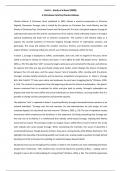Unit 6 – Study of a Novel (2000)
A Christmas Carol by Charles Dickens
Charles Dickens’ A Christmas Carol, published in 1843, follows a miserly businessman in Victorian
England, Ebeneezer Scrooge, who is visited by four ghosts on Christmas Eve: Jacob Marley, and the
Ghosts of Christmas Past, Christmas Present and Christmas Yet-To-Come. Each ghost exposes Scrooge to
sobering truths about his life and the consequences of his actions, which ultimately results in Scrooge’s
spiritual awakening and leads him to embrace compassion. The novella is still relevant today as it
exposes the societal injustices of Victorian England through themes of redemption, poverty, and
generosity. This essay will analyse the novella’s structure, themes, and character presentation, and
explore Dickens’ contextual influences and his use of literary techniques within the text.
In Stave 1, Scrooge is displayed as selfish, uncharitable, and cruel, with no regard for the poor; when
asked to donate to charity, he refuses and states “I can’t afford to make idle people merry.” (Dickens,
2003, p. 39). The adjective “idle” conveys Scrooge’s callousness and contempt for the poor and enforces
his opinion that they are lazy and should simply work harder, which displays the theme of disparity
between the rich and poor, and the upper classes’ lack of empathy. After meeting with the ghosts,
Scrooge’s mindset totally transforms and he becomes empathetic and generous; in Stave 5, Scrooge
tells Bob Cratchit “I’ll raise your salary, and endeavour to assist your struggling family” (Dickens, 2003,
p. 116). The contrast in perspective from the beginning enforces the theme of redemption - the ghosts’
lessons convinced him to re-evaluate his ethics and give back to society. Scrooge’s redemption arc
displays that even the most selfish and cynical individuals can learn kindness, assuring readers that it is
possible to change society’s perspective and promote equality.
The adjective "sole" is repeated in Stave 1 to portray Marley, Scrooge’s deceased business partner, as an
isolated individual: “Scrooge was the sole executor, his sole administrator, his sole assign, his sole
residuary legatee, his sole friend, and sole mourner” (Dickens, 2003, p. 33). The use of repetition creates
momentum which emphasises the loneliness in this statement. By listing everything that Scrooge was
the only one of to Marley, it is emphasised that nobody cared except Scrooge, implying that Marley
would not be missed. This prompts readers to imagine what a selfish life he must’ve led for him to die
with nobody who cared except Scrooge. When considering the Cratchits, this sense of absurdity is
accentuated because, though poverty-stricken, they were a loving family, while Marley died alone. This
highlights the absurdity of prioritising wealth over loved ones, making readers question the logic behind
devoting one’s life to business but yielding no substantial legacy beyond death.
Situational irony occurs throughout the novella. In Stave 3, the Cratchits are seen celebrating Christmas
despite their misfortune: “Mrs Cratchit [was concerned about] the quantity of flour… nobody said or
thought it was at all a small pudding for a large family” (Dickens, 2003, p. 81). The Cratchits appreciate
, even a small pudding, never suggesting that there isn’t enough, which displays their modesty and
gratitude. Considering their situation, readers may infer that perhaps they’d experienced Christmases
with less so are simply grateful for the luxury of pudding. Contrastingly, Scrooge repeatedly rejects
festivity, exclaiming “Humbug!” (Dickens, 2003, pp. 35-36). Ironically, the Cratchits are joyful despite
hardship, while Scrooge, a wealthy man who could afford lavish Christmas celebrations, is miserable.
The juxtaposition of Scrooge’s miserliness with the joy and generosity associated with Christmas
intensifies this absurdity, criticising upper-class morals, which encourages readers to consider their
priorities and recognise the importance of family over wealth.
Bob Cratchit is portrayed as family-oriented and grateful, representing the working class. In Stave 3,
Cratchit proposes a toast to Scrooge; “I’ll give you Mr Scrooge, the Founder of the Feast!” (Dickens, 2003,
p. 83), implying that although he is grossly exploited, he has no bitterness towards Scrooge and is
primarily thankful to work and celebrate Christmas alongside family. This strengthens Cratchit’s
characterisation as humble and family oriented – he works hard to provide and to make Christmas a
joyous occasion despite their disadvantages. This would’ve resonated with Victorian readers, as poor
working conditions were widespread due to the Industrial Revolution and the lack of welfare or worker’s
rights protections (Hopkins, 1974), so readers may’ve had similar experiences or know others who had.
Bob’s character may resonate with readers today considering the rising cost of living; more families are
struggling to afford necessities (Bernado's, 2022), therefore parents may recognise Cratchit’s struggle,
perseverance, and duty to his family.
Dickens presents Victorian London as a depressing, poverty-ridden place using vivid imagery. In Stave 4,
the Ghost of Christmas Yet-To-Come takes Scrooge to a deprived area described as “…foul and narrow;
the shops and houses wretched; the people half-naked, drunken, slipshod, ugly” (Dickens, 2003, p. 98).
This reads like the narrator is genuinely disgusted by the squalor of the setting, which is portrayed by
continuous negative adjectives, immersing readers in the scene. The adjective “narrow” creates a
confined atmosphere, provoking a sense of unease in the reader, and alluding to the extreme
overcrowding the poor experienced in Victorian London, with many living in slums (Daniels, 2003). The
description of the people enhances the sense of desperation of the poor, particularly the adjective
“drunken”, alluding to the link between poverty and alcoholism which became increasingly problematic
at this time (Brown, 1973).
The novella consists of a five-stave structure, reminiscent of a musical composition, which alludes back
to the title “A Christmas Carol” – literally a Christmas song. Each stave documents a different phase of
Scrooge’s spiritual journey. The first four each correspond to Scrooge’s encounter with a different ghost
– Marley’s ghost in Stave 1 warns Scrooge to change his ways; the Ghost of Christmas Past in Stave 2
shows Scrooge memories of his younger self; the Ghost of Christmas Present in Stave 3 shows Scrooge





